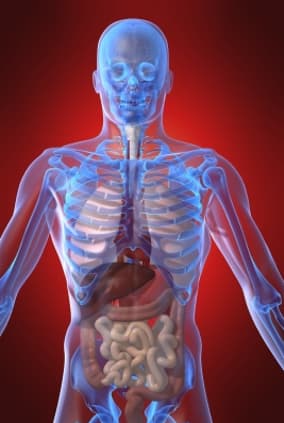INTESTINAL GAS AND BLOATING
99% of eliminated intestinal gas comprises of odourless vapours, such as oxygen, nitrogen, carbon dioxide, hydrogen, and methane. 1% sulphur-containing gases released by bacteria that are normally present within the large intestine causing an unpleasant odour.
There are two primary sources of intestinal gas: gas that is ingested (mostly swallowed air) and gas produced by bacteria that normally reside in the colon (a process called fermentation). Bloating is the full feeling individual gets due to the retention of gas in the abdomen.
DISORDERS AND FOODS ASSOCIATED WITH INCREASED GAS
- Air swallowing — a major source of gas in the stomach. Everyone typically swallows a relatively small amount of air when eating and drinking and with every normal swallow. Larger amounts of air may be swallowed when eating food rapidly, gulping liquids, chewing gum, or smoking. Most swallowed air appears to be eliminated from the stomach by belching (or "eructation"). Posture may influence how much air passes to the small intestine. In an upright position, most swallowed air tends to be expelled through the mouth. On the other hand, in a lying position, swallowed air tends to pass into the small intestine
- Belching may be involuntary or occur unintentionally - Involuntary belching is a normal process that typically follows eating and results from the release of swallowed air after enlargement or stretching (distension) of the stomach. In addition, belching may increase with certain foods that relax the ring-shaped muscle (sphincter) around the lower end of the oesophagus where it joins the stomach. Such foods include peppermint, chocolate, and fats. Chronic, repeated belching usually results from habitual swallowing of large amounts of air (i.e., aerophagia). Aerophagia is typically an unconscious process occurring with anxiety. Treatment focuses on methods to help people refrain from swallowing excessive amounts of air, such as advising people to eat slowly without gulping, and avoid carbonated beverages, chewing gum, and smoking. Specific anti-anxiety treatment may also be necessary
- Bacterial production — the digestive tract maintains a balance between healthy and potentially harmful micro-organisms. Healthy micro-organisms, also called micro flora/probiotics, are residents of the digestive tract that have a protective role in our bodies. In addition to its protective role, micro flora helps to synthesize important vitamins, nutrients and enzymes. Their preferred foods are carbohydrates (sugar, starches, and fibre in foods). Carbohydrates are normally digested by the action of enzymes in the small intestine. However, certain carbohydrates are incompletely digested, leaving them available for the bacteria in the colon to digest. The by-products of bacterial digestion include carbon dioxide, hydrogen, and methane
- Some carbohydrates, such as raffinose, are not well digested, and therefore produce increased amounts of gas. Raffinose is contained in a number of vegetables such as cabbage, Brussels sprouts, asparagus, broccoli, and some whole grains. As a result, these foods tend to cause increased amounts of gas and flatulence in most people. Starch and soluble fibre are other forms of carbohydrates that can contribute to gas formation. Potatoes, corn, noodles, and wheat produce gas while rice does not. Soluble fibre (found in oat bran, peas and other legumes, beans, and most fruit) also cause gas. Some laxatives contain soluble fibre and may cause gas, particularly during the first few weeks of use
- Another factor is variation among individuals in their ability to digest carbohydrates. A classic example is lactose, the major sugar contained in dairy products. Much of the world's adult population has a limited ability to digest lactose. Thus, consumption of large amounts of lactose by such people will lead to the production of gas often accompanied by cramping and diarrhoea. Lactose intolerance can be diagnosed by a lactose breath test, in which a measured amount of lactose in consumed, and the amount of hydrogen in breath samples is measured. Treatment involves avoidance of dairy products that contain lactose and/or supplementation with the enzyme lactase. People who avoid dairy products should take calcium supplements, since dairy products are a valuable source of calcium
- Certain diseases can also lead to excessive bloating and gas - For example, patients with diabetes mellitus or scleroderma may, over time, develop sluggishness in the peristaltic activity of their small intestine leading to constipation. This may lead to bacterial overgrowth/dysbiosis within the bowel, with poor digestion of carbohydrates and other nutrients. Excessive gas due to bacterial fermentation of the unabsorbed food can produce gassiness
- Intolerance to other sugars — In addition to lactose and raffinose, some individuals may be intolerant to other sugars contained in foods. Two common examples are fructose (contained in onions, artichokes, and pears and in some fruit drinks or soft drinks where it appears as "high fructose corn syrup") and sorbitol (a sugar substitute contained in some sugar free candies and chewing gum)
- Diseases that cause impaired absorption of carbohydrates (carbohydrate malabsorption). Carbohydrate malabsorption can occur in patients with celiac disease (a disease caused by intolerance to gluten - a protein contained in wheat, oats, rye, and barley), short bowel syndrome, cystic fibrosis, Whipple disease, acrodermatitis enteropathica, biliary atresia and pernicious anaemia, which can lead to increased gas in the intestines
NATUROPATHIC TIPS TO HELP PREVENT EXCESSIVE GAS
- Try to identify and avoid the foods that affect you the most. Some of the worst offenders for many people include beans, onions, broccoli, Brussels sprouts, cauliflower, artichokes, asparagus, pears, apples, peaches, prunes, sugar-free candies and chewing gum, whole-wheat bread, bran cereals or muffins, beer, sodas and other carbonated beverages, milk, cream, ice cream and ice milk.
- Try cutting back on fried and fatty foods. Often, bloating results from eating fatty foods. Fat delays stomach emptying and can increase the sensation of fullness.
- Temporarily cut back on high-fibre foods. Add them back gradually over weeks. If you take a fibre supplement, try cutting back on the amount you take and build up your intake gradually. Be sure to take fibre supplements with at least 8 ounces of water and drink plenty of extra liquids throughout each day.
- Reduce your use of dairy products. Try using low-lactose dairy foods, such as yogurt, instead of milk. Consuming small amounts of milk products at one time and or consuming them with other foods also may make them easier to digest. In some cases, however, you may need to eliminate dairy foods completely.
- Try smaller meals. Eat several small meals throughout the day instead of two or three larger ones.
- Eat slowly, chew your food thoroughly and don't gulp. If you have a hard time slowing down, put down your fork between each bite.
- Avoid chewing gum and eating hard candies. These activities can cause you to swallow more air.
- Don't eat when you're anxious, upset or on the run. Try to make meals relaxed occasions. Eating when you're stressed can interfere with digestion.
- Don't smoke. Cigarette smoking can increase the amount of air you swallow.
- Try a cup of peppermint tea. Peppermint oil contains menthol, which appears to have an antispasmodic effect on the smooth muscles of your digestive tract. You may find that a warm cup of peppermint tea can provide relief from gas and gas pain. On the other hand, peppermint may contribute to heartburn and acid reflux
Related Articles
Candidiasis
Candida overgrowth in the gastrointestinal tract is now becoming recognized as a complex medical syndrome known as chronic candidiasis or the yeast syndrome. Symptoms include: Multiple food allergies, or allergic to all foods( pan allergic), alternating diarrhea with constipation.
Chronic Fatigue
Chronic Fatigue Syndrome (CFS) is described as a severe, debilitating fatigue, lasting at least six months (of new and definite onset), associated with at least four of the following symptoms: impaired memory or concentration, sore throat, muscle pains, joint pains, unrefreshing sleep and post-exertion malaise.
Irritable Bowel Syndrome
Irritable bowel syndrome (IBS) - a diagnosis of exclusion, this condition is often misdiagnosed. Severe food intolerances / allergies may exhibit symptoms that are similar to Irritable Bowel Syndrome such as pain, cramping, gassiness, sudden bouts of diarrhoea, and constipation.







